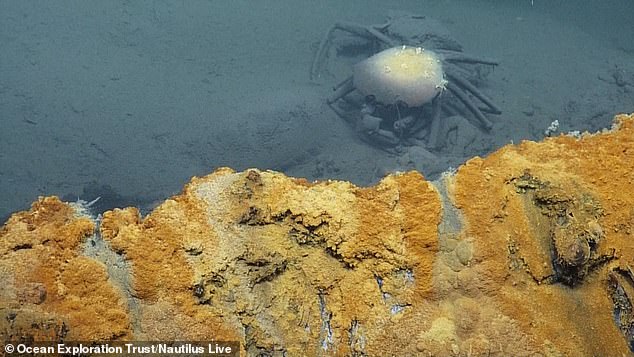With a name like “The Hot Tub of Despair,” it might not surprise you to learn that this strange structure is more dangerous than it first appears.
Although at first glance it may appear to be a harmless pool of murky water, the Jacuzzi of Despair is so deadly that almost everything that enters it dies instantly.
The 100-foot (30.5 m) wide “bottomless” pool contains a toxic mix of ultra-salty water, methane and hydrogen sulfide that only a handful of creatures can survive.
When it was discovered in 2015, researchers found that the shores were littered with the preserved carcasses of creatures that had tried to swim in the warm waters.
And to make things even stranger, this pool lies more than 1,000 meters (3,300 feet) beneath the waves of the Gulf of Mexico.
This pool contains a highly salty brine mixture that is toxic to any creature unlucky enough to fall into it. Note the dead crab in the pool.

In 2015, researchers discovered a site dubbed the “Hot Tub of Despair” 1,000 meters (3,300 feet) beneath the waves of the Gulf of Mexico.
The Hot Tub of Despair was discovered by the Ocean Exploration Trust as part of an investigation into “cold seeps” deep in the Gulf of Mexico.
These are regions where dense hydrocarbons, the basis of oil and gasoline, are expelled from beneath the seabed into the water column.
Cold water seeps form on top of vast layers of salt that were created when ancient oceans evaporated.
As these salt layers shift and crack, the resulting gaps allow compounds that are normally trapped underground to escape.
Sometimes, when these cracks form, deep water in the sediment layers dissolves huge amounts of salt to form a brine four times saltier than seawater.

Researchers found the bodies of several crabs that had been “pickled” in brine for so long that mineral deposits were beginning to form on their bodies (pictured).
Because this brine is so dense, it settles to the bottom of the ocean and cannot easily mix with the surrounding salt water.
Where salt water bubbles up from the ground, “brine pools” can form – strange underwater lakes and ponds like the Jacuzzi of Despair.
While piloting a remotely operated vehicle called Hercules, researchers found a thin, steep wall, composed mostly of deposited minerals and live mussels, rising three meters above the seafloor.
They found it contained a 3.7m-deep layer of brine above a “bottomless” pool of liquefied mud.
Even after extending a sampling line more than 60 feet (19 m) into the pool, researchers were never able to find the bottom.
The salt water inside is much warmer than the surrounding area, reaching 19 °C (66 °F), and is deadly to any large creature that enters, giving the pool its ominous nickname.

Although the brine itself is 12 feet (3.7 m) deep, when the remotely operated vehicle inserted a probe (pictured) they were unable to find the bottom of the liquefied mud layer even after 60 feet (19 m).
Researchers located the bodies of several crabs and arthropods that had been “pickled” by salt water.
Due to the intense salinity and high levels of methane and hydrogen sulfide from the bubbling hydrocarbons, entering the brine pool is often fatal.
In a video of the expedition shared by Nautilus Live, one of the researchers says: ‘These types of larger organisms really don’t like being in this fluid.’
In one case, researchers detected the body of a large crab on top of an arthropod, both dead in the brine.
They suggested the crab may have seen the arthropod’s body in the pool and followed it in hopes of finding an easy meal.
In the absence of oxygen, the bacteria that normally decompose bodies simply cannot survive.

The pool forms where layers of salt formed by evaporation of ancient oceans shift and crack, allowing hydrocarbons and salt water to erupt from below.
Some of the bodies had been in the water for so long that they were covered in a layer of mineral deposits that included large halite crystals.
The researcher added: “Maybe they just come here to die. They are preserved in perpetuity, basically embalmed here.”
However, as deadly as the Jacuzzi of Despair can be to most creatures, some life forms have been able to flourish.
In fact, researchers believe that living beings may have been partly responsible for helping the pond form.
One researcher said in the video: “Initially, what probably happens is that fluid starts to well up from the seafloor, and then biological communities emerge that start to take advantage of that.”
On the wall of the brine pool, the expedition team found two species of mussels that appeared to play a key role in keeping the wall intact.

The pool wall is held together by a colony of mussels that thrive in the toxic waters.

These mussels (pictured) contain bacteria in their gills that can convert dissolved gases into energy for their hosts and support an active ecosystem with many different species.
As the researchers note in a summary of the expedition’s findings, these mussels contain symbiotic bacteria in their gills that convert dissolved gases into energy for their hosts.
These bacteria support a small but complex ecosystem of mussels, worms, corals and small animals in and around the deadly brine.
In a video captured by the expedition team, researchers even observed a fish repeatedly diving into the brine pool and swimming toward the edges.
It has been theorized that this fish may have been brine tolerant and was diving into the pool to feed, although researchers say it may simply have been sick.
The ecosystems surrounding these strange and hostile regions of the planet are vital to our scientific understanding of life.
By observing how life forms can adapt and thrive in the most extreme conditions, scientists may one day be able to shed light on the origins of life on Earth and how life may form on distant planets.


